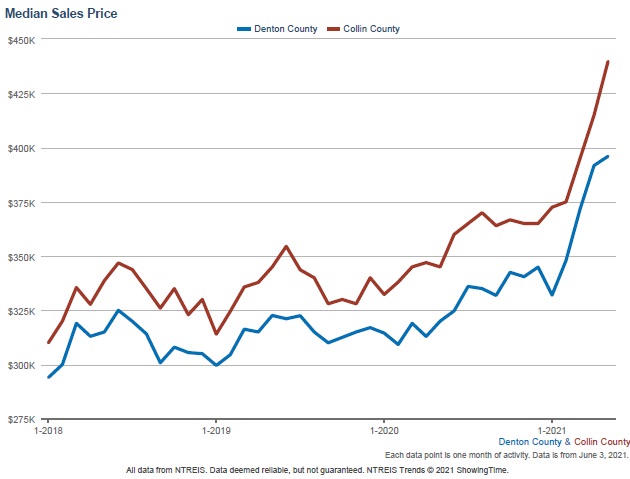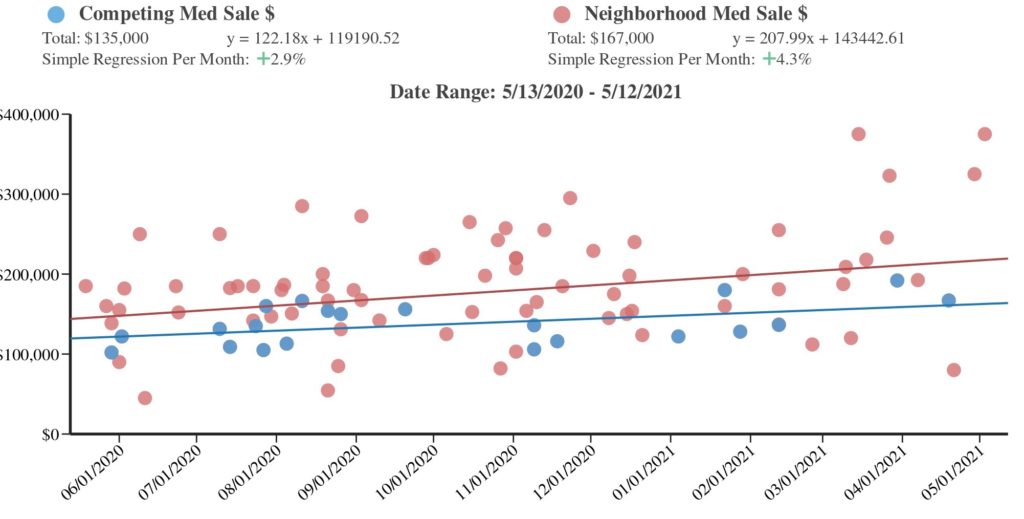How do appraisers adjust for time in rapidly increasing markets?

If you are like me, you are probably tired of hearing the word “unprecedented”. How many times have we said it or read it this past year? What is another word we can use? Remarkable? Extraordinary? Phenomenal? However we describe it, we are currently experiencing rapidly appreciating real estate markets. Not just in our local North Texas markets but in many places nationwide. Record low supply of real estate coupled with high demand is driving up the prices. You hear about bidding wars and how difficult it is to buy a home in this market. Mortgage interest rates remain at record lows, builders are struggling to keep up as the cost of construction is at record highs and the demand for work from home space has increased as a result of the pandemic.
What are appraisers to do?
Appraisers are working harder than ever. The demand for appraisal services is great and in the current market conditions, it can be difficult. Appraisers use closed comparable sales to derive value from the marketplace, but what if those sales closed 60 days ago and the market has already increased since that time? Appraisers can determine a market condition adjustment based on time (also known as a time adjustment). If the most similar sale sold 4 months ago and the market is either increasing or decreasing then an adjustment can be determined to bring that sale to current market conditions.
How do appraisers determine the market conditions adjustment?
The appraiser can look at sales within the market and analyze sale price trends. The market condition adjustment should come from competing sales and not just all sales within the market. For our appraisals, we do look at the overall trends for all sales within the market but use competing sales to determine the amount of adjustment to make. The adjustment can be made as a percentage. Some appraisers make an adjustment based on the market change per day. We typically determine sale trends for the past 12 months and then divide that into months. A 20% price increase would adjust the sales price at 1.6% per month. Each comparable would be adjusted a percentage based on the time of the contract.
It is worth noting that not every market segment is experiencing rapid price appreciation. Appraisers will analyze the neighborhood and market for similar competing sales of the property they are appraising. Don’t let the headlines fool you. Just because you read that home sales are up 20% from last year,that does not necessarily mean that your home is now worth 20% more.
Tools and Resources for Appraisers
There are many tools out there for appraisers to use. Here are a few :
Spark for Appraisers
This is a data import tool but also includes market analysis tools as well as cost data tools for appraisers. Spark is not available in all areas. Here is a video from Spark discussing how appraisers can determine market condition adjustments in Spark. Don’t worry if it is not in your area, because the video also shows how to calculate the adjustment without Spark using excel.

George Dell Classes
George Dell has a free blog and newsletter. He also teaches a Stats, Graphs, and Data Science class for appraisers. He is often a featured writer for Appraisal Today Because of these current market conditions, he is offering a free class for appraisers on time adjustments. You can sign up at this link: Free 2 Hour Webinar. The seating is limited to 500 and it fills up so I wouldn’t hesitate to sign up.
Appraiser eLearning
Appraiser eLearning offers many educational courses for appraisers. They have just released a new webinar for appraisers in helping to determine market time adjustments. This is not a free webinar but is only $49. The instructors are Tim Anderson and Scott Cullen. Tim is a Certified USPAP instructor and appraiser advocate. Scott Cullen has created the Solomon Calculators tools for appraisers. The webinar is on June 8th. You can register at this link: USPAP Compliant Adjustment Series, Course #1- Market Time Adjustments
These are just a few resources that I am aware of to help appraisers determine the market condition adjustments. This is not an exhaustive list. Appraisers, I would love to know how you determine market adjustments. What other tools or resources do know? Please comment below so we can help each other provide credible assignment results for our clients.
Great post, Shannon! Analyzing current listings and pending sales is also an effective method to help provide support for an increasing market. It is my opinion that an appraisal MUST also include pending sales and active listings in order to provide a current look at the market in addition to the historical perspective that closed sales provide.
Thanks, Tom. Yes, I failed to mention current listings and pending sales but they are VERY important especially in a rapidly changing market.
Nice job. I find myself relying heavily on the trendline in my scatter graphs and considering current pendings (and conversations with agents about those properties). Large adjustments have been fully warranted and supported lately.
By the way, I’m tired of the word “weird”. We’ve used it so much in terms of, “It’s been such a weird year….” Yet I probably say that as much as everyone else of course. 🙂
I ,too, am weary of “weird”. It has been an indescribable year- ha!
I agree that scatter plot graphs with trendlines is the way to go. It’s what George Dell teaches as well as what we do in Spark. The Spark video teaches anyone how to do this technique in excel. You don’t have to be a Spark user to do it. It shows support in an understandable way and helps the appraiser reconcile the market appreciation.
Great post Shannon. I use these methods on a daily basis. What I find hard is when the rate of change changes. If I can track steady increases, I’ll make the adjustment. But when the market accelerates, I can under or overshoot.
I’m shocked to hear some appraisers still do not make time adjustments. Thanks for sharing these resources.
Thanks, Joe! Yes, it can be tricky. I generally run the trends for both median sales price and price per square foot. The numbers give me a range and then my appraiser judgement comes into play. Looking at the pending and active listings can really help to see when the rate is changing.
I shared these resources because many appraisers have been in stable markets so it’s great to get some guidance and help when the market is changing. Thanks so much for your input.
What is Spark?
Hi Rachelle! Spark is a tool for appraisers that assist in importing comparable sales into your reports (which save time), and it assists in analyzing market data. It is created by appraiser Brandon Reich and is one of my most favorite tools. It is not available in all areas but you can check out the website and if it is available in your area then I recommend the 2 week free trial. Here is the link: https://landing.sparkforappraisers.com/
If it is not available in your area, then I recommend checking out Datamasters. It is similar assisting in importing comparables as well as analyzing the market data. They also have a free trial. Here is a link to Datamasters: https://www.datamasterusa.com/
Hope this helps!
Thank you Shannon!
You’re welcome!